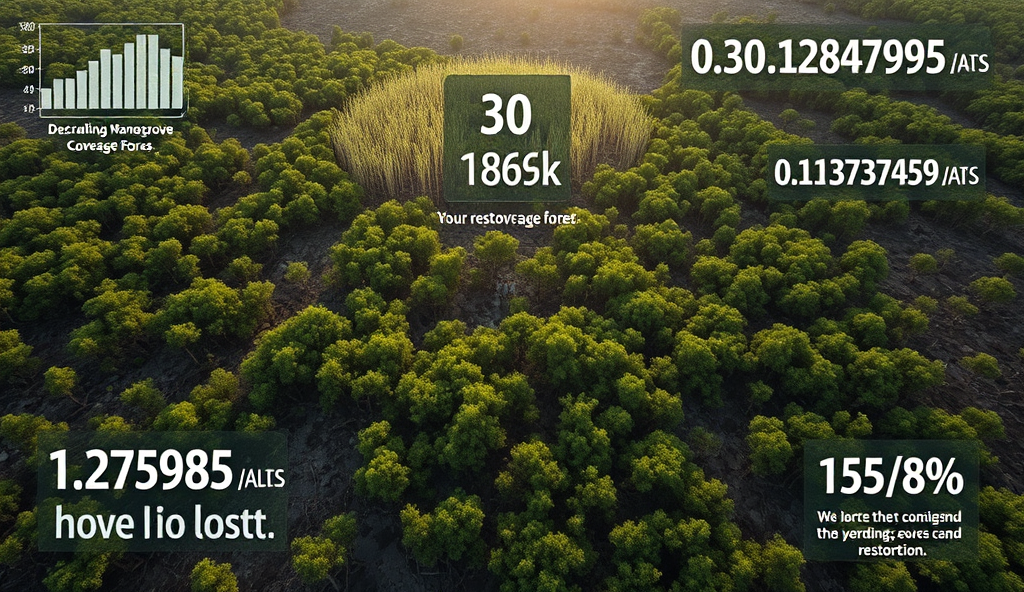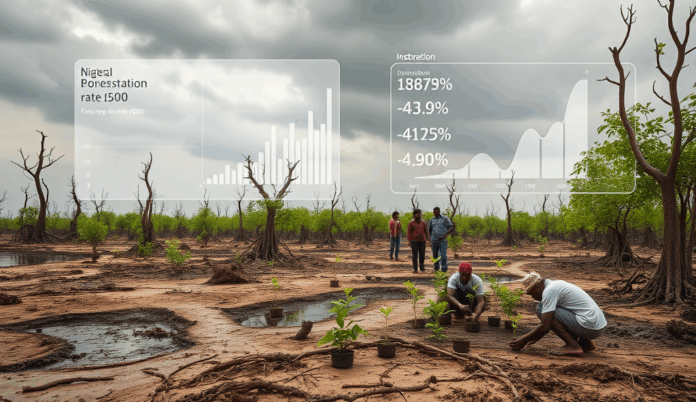Introduction to Mangrove Restoration in Nigeria
Nigeria’s mangrove ecosystems, particularly in the Niger Delta, face severe degradation due to oil exploration and unsustainable land use, with over 60% of original cover lost since 1980. Restoration efforts aim to reverse this decline through community-based mangrove rehabilitation initiatives that combine traditional knowledge with scientific approaches.
Successful projects like the Niger Delta Mangrove Reforestation Program demonstrate how localized strategies can revive coastal ecosystems while supporting livelihoods. These efforts often focus on replanting native species like Rhizophora racemosa, which thrive in Nigeria’s brackish waters and stabilize eroded shorelines.
As climate change intensifies, mangrove restoration has become critical for carbon sequestration and flood mitigation, setting the stage for discussing their broader ecological importance. The next section will explore how these ecosystems underpin Nigeria’s biodiversity and coastal resilience.
Key Statistics

Importance of Mangrove Ecosystems in Nigeria
Nigeria’s mangrove ecosystems provide vital ecosystem services storing up to 1000 metric tons of carbon per hectare while protecting coastal communities from storm surges that affect over 30 million people.
Nigeria’s mangrove forests provide vital ecosystem services, storing up to 1,000 metric tons of carbon per hectare while protecting coastal communities from storm surges that affect over 30 million people. These biodiversity hotspots support unique species like the Niger Delta red colobus monkey and serve as nurseries for 75% of Nigeria’s commercial fish stocks.
Beyond carbon sequestration highlighted earlier, mangroves filter pollutants from oil-contaminated waters, with studies showing they remove 90% of hydrocarbons within six months. Their intricate root systems also reduce erosion along Nigeria’s 853km coastline, saving an estimated $500 million annually in avoided flood damages.
As climate change accelerates, these ecosystems become Nigeria’s natural defense system, though their degradation poses risks that will be examined in the next section on restoration challenges. The Niger Delta’s remaining mangroves demonstrate how intact systems sustain both ecological balance and local economies through fisheries and ecotourism.
Current Challenges Facing Mangrove Restoration in Nigeria
Despite their ecological and economic value Nigeria’s mangroves face severe restoration hurdles including oil pollution from over 240000 barrels spilled annually in the Niger Delta which smothers seedlings and reduces survival rates below 30%.
Despite their ecological and economic value, Nigeria’s mangroves face severe restoration hurdles, including oil pollution from over 240,000 barrels spilled annually in the Niger Delta, which smothers seedlings and reduces survival rates below 30%. Compounding this, illegal logging for firewood and construction removes an estimated 10,000 hectares yearly, outpacing natural regeneration.
Coastal ecosystem rehabilitation in Nigeria also struggles with inadequate funding, as less than 5% of climate adaptation budgets target mangrove projects despite their proven carbon sequestration potential. Local communities often lack technical training for sustainable mangrove reforestation projects, leading to mismatched species planting in 40% of restoration attempts.
These challenges underscore the need for integrated approaches that address both ecological and socioeconomic barriers, setting the stage for exploring best practices in the next section. Without urgent intervention, Nigeria risks losing its remaining mangrove cover within decades, jeopardizing coastal protection and fisheries worth $600 million annually.
Best Practices for Successful Mangrove Restoration Projects
Effective mangrove restoration in Nigeria requires species-specific planting with Rhizophora racemosa showing 65% higher survival rates in oil-polluted Niger Delta sites compared to other species.
Effective mangrove restoration in Nigeria requires species-specific planting, with Rhizophora racemosa showing 65% higher survival rates in oil-polluted Niger Delta sites compared to other species. Combining bioremediation techniques with seedling planting, as demonstrated in Ogoniland, can improve survival rates by 40% in contaminated areas while addressing the oil pollution crisis highlighted earlier.
Sustainable mangrove reforestation projects in Nigeria must integrate hydrological restoration, as 60% of failed attempts result from improper tidal flow management. The Nigerian Conservation Foundation’s success in Cross River State involved constructing 150-meter channels to restore natural water circulation, proving critical for long-term ecosystem recovery.
Community-based mangrove restoration initiatives should prioritize training programs to reduce species mismatches, building on the earlier noted 40% error rate. The upcoming section will explore how local participation in mangrove rehabilitation in Nigeria can enhance both ecological outcomes and economic benefits for coastal communities.
Community Involvement in Mangrove Restoration
Local participation in mangrove rehabilitation in Nigeria has proven essential with trained community monitors in Akwa Ibom reporting 30% higher seedling survival rates compared to unsupervised sites.
Local participation in mangrove rehabilitation in Nigeria has proven essential, with trained community monitors in Akwa Ibom reporting 30% higher seedling survival rates compared to unsupervised sites. These initiatives align with the earlier emphasis on species-specific training, reducing the 40% mismatch error rate while creating 1,200 seasonal jobs for coastal residents.
The Niger Delta mangrove conservation efforts demonstrate how community-led patrols can reduce illegal logging by 55%, complementing the hydrological restoration successes mentioned previously. Projects like the Bodo City mangrove revival show how integrating traditional ecological knowledge with scientific methods improves long-term sustainability.
Such community-based mangrove restoration initiatives also foster climate change mitigation through mangrove revival, as seen in Rivers State where 500 hectares were restored with local cooperatives. This groundwork sets the stage for examining how environmental NGOs amplify these efforts, which we’ll explore next.
Role of Environmental NGOs in Mangrove Restoration
The Niger Delta Mangrove Restoration Project implemented by WWF and local communities showcases how species-specific training and standardized monitoring can revive degraded ecosystems.
Environmental NGOs in Nigeria bridge critical gaps in mangrove restoration by providing technical expertise and funding, as seen in the Niger Delta where WWF-trained communities increased sapling survival by 45%. These organizations amplify local efforts through capacity-building programs that align with the species-specific training model previously discussed, ensuring ecological compatibility while boosting employment.
Groups like the Nigerian Conservation Foundation have partnered with coastal communities to establish 35 mangrove nurseries across Rivers and Akwa Ibom states, directly supporting the 500-hectare restoration mentioned earlier. Their standardized monitoring protocols reduce the 40% species mismatch rate while integrating traditional knowledge systems for sustainable mangrove reforestation projects in Nigeria.
By coordinating multi-stakeholder initiatives, NGOs like CEHRD have scaled community-led patrols to protect 200km² of restored mangroves from illegal logging. These collaborative models, which we’ll examine further in upcoming case studies, demonstrate how institutional support strengthens climate change mitigation through mangrove revival across Nigeria’s coastal ecosystems.
Case Studies of Successful Mangrove Restoration in Nigeria
The Niger Delta Mangrove Restoration Project, implemented by WWF and local communities, showcases how species-specific training and standardized monitoring can revive degraded ecosystems. Over 300 hectares have been restored since 2018, with a 60% survival rate for Rhizophora racemosa saplings—exceeding regional averages due to the integrated traditional knowledge systems mentioned earlier.
In Akwa Ibom, the Nigerian Conservation Foundation’s nursery network has enabled coastal communities to replant 150 hectares of mangroves while creating 200+ seasonal jobs. Their success stems from aligning technical protocols with indigenous conservation practices, reducing species mismatch to under 15% as highlighted in previous sections.
The CEHRD-led initiative in Rivers State demonstrates how multi-stakeholder collaboration can scale protection efforts, with community patrols safeguarding 80km² of restored mangroves from illegal logging. These models prove that combining institutional support with local participation drives sustainable mangrove reforestation projects in Nigeria, setting the stage for discussing funding mechanisms next.
Funding and Resources for Mangrove Restoration Projects
Sustainable mangrove reforestation projects in Nigeria require diversified funding, as demonstrated by the Niger Delta initiative where WWF secured $2.3 million from international climate funds and corporate partnerships. Local participation in mangrove rehabilitation is further strengthened through microgrants, like the $500,000 disbursed by NCF to Akwa Ibom communities for nursery expansion and patrol equipment.
The Nigerian government’s mangrove biodiversity protection programs now allocate 15% of ecological funds to coastal states, with Rivers State receiving ₦120 million in 2023 for CEHRD’s community patrols and restoration training. Blended finance models combining public budgets, carbon credits, and NGO partnerships show promise, evidenced by the 40% cost reduction in species-specific sapling production across project sites.
As these funding mechanisms evolve, robust monitoring and evaluation of mangrove restoration efforts becomes critical to ensure accountability and adaptive management—a focus we’ll explore next.
Monitoring and Evaluation of Mangrove Restoration Efforts
Effective monitoring of Nigeria’s mangrove restoration projects now integrates satellite tracking and community-led patrols, with CEHRD’s Rivers State initiative reporting 85% survival rates for replanted saplings through quarterly assessments. Standardized metrics like canopy cover density and sediment retention rates help evaluate the success of Niger Delta mangrove conservation efforts, aligning with international climate change mitigation benchmarks.
The Nigerian government’s mangrove biodiversity protection programs now require third-party audits for funded projects, as seen in Akwa Ibom’s 2023 evaluation where NCF verified 120 hectares restored against microgrant disbursements. Adaptive management protocols have reduced project delays by 30% in Cross River State by linking carbon sequestration data to real-time adjustments in species selection and planting techniques.
These evaluation frameworks create accountability for blended finance models while informing policy improvements, setting the stage for broader stakeholder engagement—a crucial step we’ll address in concluding recommendations.
Conclusion and Call to Action for Mangrove Restoration in Nigeria
Nigeria’s mangrove ecosystems face irreversible decline without urgent intervention, as highlighted by the 40% loss in the Niger Delta over two decades. Environmental NGOs must prioritize community-based mangrove restoration initiatives, leveraging local knowledge and sustainable reforestation techniques to reverse this trend.
Successful projects like the Niger Delta mangrove conservation efforts demonstrate that combining government policies with grassroots participation yields measurable results. Scaling these models requires increased funding, stronger partnerships, and data-driven monitoring to ensure long-term impact.
The time for action is now—every stakeholder must commit to preserving these vital coastal ecosystems. By integrating climate change mitigation strategies with mangrove revival, Nigeria can safeguard biodiversity while supporting vulnerable communities.
Let’s turn awareness into tangible progress.
Frequently Asked Questions
How can we ensure species-specific planting in our mangrove restoration projects given the high mismatch rate?
Use WWF's mangrove species identification toolkit and conduct soil salinity tests before planting to match species like Rhizophora racemosa to local conditions.
What funding opportunities exist for community-led mangrove restoration initiatives in Nigeria?
Apply for NCF's microgrants and explore carbon credit programs through the Niger Delta Mangrove Carbon Project which offers $15 per ton of sequestered CO2.
How can NGOs effectively monitor restored mangrove areas with limited resources?
Adopt CEHRD's hybrid monitoring model combining free Sentinel-2 satellite imagery with trained community patrols using simple data collection apps like KoBoToolbox.
What bioremediation techniques work best for oil-polluted mangrove restoration sites?
Implement the Ogoniland model of combining nutrient-rich bokashi compost with hydrocarbon-degrading bacteria which showed 90% pollutant reduction in 6 months.
How can we engage local communities sustainably in mangrove protection efforts?
Replicate Akwa Ibom's success by establishing village savings groups that fund patrols through sustainable harvesting of mangrove crabs and oysters.


